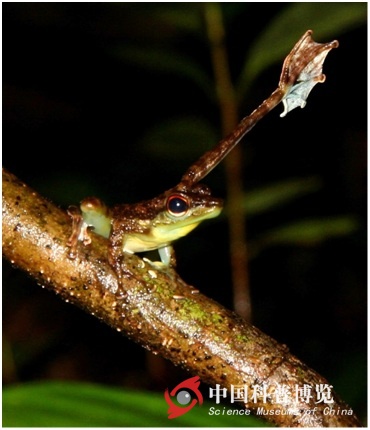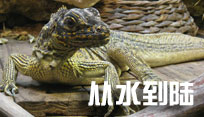作者:千与
毫无疑问,两栖无尾类主要通过声音通讯的方式进行交流。无尾类的鸣叫行为复杂多变,用途十分广泛,常见的有广告鸣叫、争斗鸣叫、求爱鸣叫、遭遇鸣叫、求救鸣叫和释放鸣叫等鸣叫方式。
人们在发现青蛙会叫的同时也发现它们有一个能够膨大的鸣囊,而且这个鸣囊还是个效果很好的共振箱——能够将声音信号放大许多倍。因此,人们认为鸣囊是无尾类促进鸣叫效率提高的进化产物。鸣囊通过降低体腔与环境的阻抗失调使声音能量损失达到最少,增加鸣叫率并使声音朝大范围角度传播。然而大家并没有认识到不断伸缩的鸣囊也是一种视觉信号。
后来发现许多无尾类都具有颜色各异、形态迥然的鸣囊,认为膨大的鸣囊在配偶选择的过程中作为一种视觉信号与鸣叫信号共同作用。雌泡蟾明显偏好带有鸣囊视觉信号和声音信号结合的刺激。并且推测鸣囊的视觉线索主要用于大合唱时对潜在配偶和竞争对手的侦测和定位。但是这种视觉信号仅仅只是鸣叫信号的补充,并不能独立发挥作用。
第一次证明在雄性保护领地时颤动的鸣囊具有视觉线索的是箭毒蛙。只有存在声音信号和视觉信号双重刺激时,雄性箭毒蛙才会有打斗行为。鸣囊上亮丽的颜色是一种重要的展示,东非溪流蟾蛙即使不叫,黄色的鸣囊也能引发雄性间的争斗。地栖的白唇蛙鸣囊不断伸缩敲击地面产生一种震动信号来克服异种间合唱造成的噪音干扰。雄性红眼树蛙甚至通过植物枝干的震动来警告入侵者。后来的诸多实验终于证明视觉展示既可以与声音信号共同作用,也可以不依赖声音信号独立表达具体内容。
无尾类最引人注意并广为人知的视觉信号行为是“foot flagging”,即“招手”行为。雄性圆点湍蛙(
Staurois guttatus)招手的时候后腿抬起并伸直,充分展开脚趾间彩色的蹼带,姿势十分有趣。据报道,目前有16种无尾类具“招手”行为,主要用于领地保护和雄性竞争。声音信号容易受到环境噪音的干扰,而视觉信号则不存在这样的问题。所以,人们推测婆罗湍蛙的招手行为是其在嘈杂的溪流环境中进行通讯的有效手段。多半蛙的招手行为会紧跟鸣叫行为后发生,但人们也发现跳舞蛙的招手行为并没有与鸣叫行为一起形成复合信号。Preininger等人推测这种显而易见的招手行为是身体攻击的仪式化。争斗性的招手行为可以近一步发展成为“踢腿”行为,这种打斗技巧主要用于近距离的遭遇战,跟羚羊的恐吓动作相似。
无尾类视觉信号行为的另一个例子是繁殖期的雄性摩尔蛙会暂时得着上蓝色。这种视觉信号能够快速进行配偶识别。
视觉信号不管是取代声音信号独立发挥作用,还是与其耦合共同发挥作用,都已经彻底改变了我们对于无尾两栖类信号通讯行为的认识。

图1. (From top left to bottom right): Sympatric male individuals of Hyperolius cinnamomeoventris, H. kivuensis, H. viridiflavus and H. lateralis with inflated vocal sac. The prominent gular patch is visible in all pictures.

图2. Male Staurois guttatus performing the agonistic visual signal termed “foot flagging” with his left hind leg
中国科普博览-从水到陆专栏
首发
转载请注明出处:http://csar.blog.kepu.cn/
所有照片均来自参考文献
参考文献
Bucher TL, Ryan MJ, Bartholomew GA (1982) Oxygen-consumption during resting, calling, and nest building in the frog
Physalaemus pustulosus. Physiol Zool 55:10-22.
Pauly GB, Bernal XE, Rand AS, Ryan MJ (2006) The vocal sac increases call rate in the T ngara frog Physalaemus pustulosus. Physiol Biochem Zool 79:708-719.
Preininger D, Stiegler MJ, Gururaja KV (2013) Getting a kick out of it: multimodal signalling during male-male encounters in the foot-flagging frog
Micrixalus aff.
saxicola from the Western Ghats of India. Curr Sci India 105:1735-1740.
Taylor RC, Klein BA, Michael J (2011) Inter-signal interaction and uncertain information in anuran multimodal signals. Curr Zool 57:153-161.
Narins PM, Grabul DS, Soma K et al (2005) Cross-modal integration in a dart-poison frog. Proc Nat Acad Sci 102:2425-2429.
Narins PM, Feng AS, Fay RR (2007) Hearing and sound communication in amphibians. Springer, New York.
Hirschmann W. (2006) Visual signaling in Phrynobatrachus krefftii Boulenger, 1909 (Anura: Ranidae). Herpetologica 62:18-27.
Lewis E, Narins PM, Cortopassi K et al (2001) Do male white-lipped frogs use seismic signals for intraspecific communication? Integr Comp Biol 41:1185-1193.
Cardoso AJ, Heyer WR (1995) Advertisement, aggressive, and possible seismic signals of the frog
Leptodactylus syphax (Amphibia, Leptodactylidae). Alytes 13:67-76.
Preininger D, Boeckle M. (2009) Communication in noisy environments II: visual signaling behavior of male foot-flagging frogs
Staurois latopalmatus. Herpetologica 65:166-173.
Grafe TU, Preininger D, Sztatecsny M et al (2012) Multimodal communication in a noisy environment: a case study of the Bornean rock frog
Staurois parvus. PLoS One 7:e37965.
Smith CL, Evans CS (2011) Exaggeration of display characteristics enhances detection of visual signals. Behaviour 148:287-305.
Sztatecsny M, Strondl C, Baierl A et al (2010) Chin up: are the bright throats of male common frogs a condition-independent visual cue? Anim Behav 79:779-786.
Caldwell MS, Johnston GR, McDaniel JG, Warkentin KM (2010) Vibrational signaling in the agonistic interactions of red-eyed treefrogs. Curr Biol 20:1012-1017.







